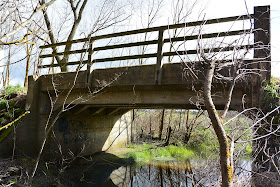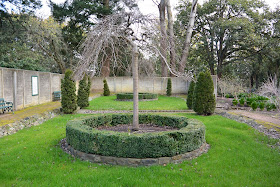Wood was cheap and readily available and timber bridges were quick to build. The downside however was that they had an effective lifespan of around ten years before substantial ongoing repair and maintenance was required. Stone was another plentiful building material - especially across the basalt plains through which the rivers of the Barwon catchment run - however it was expensive and time consuming to build in stone. As a result, scores of smaller creek and river crossings made do with fords or timber bridges.
One way to minimise costs was to construct bridges from a combination of building materials. Bluestone abutments were commonly used to support a timber deck - as was the case of the Blue Bridge over the Moorabool River on the Yendon-Egerton Road - or they could be added later to reinforce a crumbling embankment. The latter was the case when repairs to the original timber bridge at the Leigh Grand Junction were required.
There were of course, other factors to consider too. During the summer months, timber bridges were at risk from bushfire and constant exposure to water meant rot was a permanent problem. Stone structures were less likely to be affected by fire and were impervious to water, but all bridges were to a greater or lesser extent susceptible to flood damage. Over the years these factors have resulted in a number of bridges across the Barwon catchment which reflect not only the ravages of age and the environment, but also provide a visual time line of changing construction materials and building techniques as progressive repairs were implemented.
The first example which comes to mind is the Old Five Mile Bridge which crosses Sutherland Creek's west branch on the Steiglitz Road from Geelong. Today, the bridge sits disused and all but unnoticed beside the modern, two-laned Ken Middleton Bridge which now carries all traffic. The old bridge however is a time capsule which represents the evolution of bridge maintenance in the Borough of Steiglitz and the shires of Meredith and Bannockburn.
 |
| Sign still in place at the bridge |
 |
| View underneath the bridge, looking north which shows the timber stringers showing signs of decay and the original piles along with the newer steel beams and deck |
It was re-decked in 1871, again required repair in 1873 and then in 1874 was declared unsafe even for ordinary traffic, but little more is mentioned in the newspapers until the spring of 1880 when the Moorabool River and surrounding waterways experienced the largest flood in recorded history to that date.
Several bridges were described as having been washed away, including the Five Mile Bridge. Naturally, it was necessary to rebuild and it was common practice to cut costs by reusing any salvageable material, although whether this occurred here I do not know. With the rebuild underway, it was discovered in March, 1881 that the new structure was being built on soft, loamy, clay soil and in order to secure it, the bridge would have to be partially dismantled and then reconstructed using a significantly greater amount of timber than originally anticipated. The council considered the issue and called for tenders to either repair the existing structure or build a new one. Ultimately it was decided that the better option was to build a new bridge, however rather than replicate the existing 24 ft bridge, it was decided that the new structure would be 12 ft wide. The contract was eventually awarded to E Kennealey whose tender of £114 was accepted. In addition to completing the job, Kennealey also agreed to purchase some of the used timbers from the previous structure, however the following year, with payment still owing, the council abandoned the agreement.
 |
| Looking north along the deck of the old bridge. The new Ken Middleton Bridge can be seen to the left of the picture |
All this reconstruction however was ultimately for naught. In February, 1883 the creek flooded once more and the bridge was destroyed a second time. By September the shire was again calling for tenders for its reconstruction, indicating that a 66 ft wooden bridge over Sutherland's Creek was required. At this time, engineer Robinson had been given a leave of absence pending a council decision on his continued employment and it was left to the acting (and unqualified) engineer Mr J Murphy to deal with the matter. Murphy appealed to the engineer of neighbouring Leigh Shire - none other than CAC Wilson - to draw up plans for the bridge, however Wilson who was on leave at that time, sent one of his sons (possibly Frederick who later served as shire engineer to Meredith) to take the levels. The younger Wilson upon assessing the situation felt that it would be impossible to sink piles deep enough to stabilise the bridge, as the surrounding rock was too hard and too near the surface.
The bridge was almost destroyed yet again in 1898. This time however, the threat was fire, not flood. Fortunately, the coach service from Geelong to Steiglitz happened to be passing and the driver noticed smoke billowing from under the deck. He quickly raised the alarm at a neighbouring farm and the fire was extinguished before it could take proper hold of the timber decking. It was supposed that a camper had failed to properly put out a campfire underneath the bridge.
of £91 would make it good for a further 12 years.
 |
| The bridge as it stands today showing original timbers in along with steel and concrete additions |
 |
| Looking south over the new bridge, named for former Bannockburn Shire engineer, the late Ken Middleton |





















